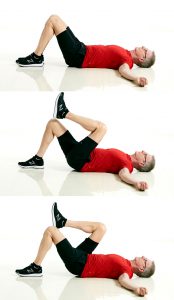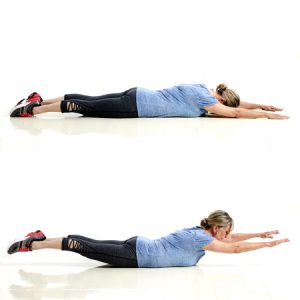4 Exercises to Avoid with Sciatica (and What to Do Instead)
Make these simple swaps to stay active with minimal risk of stoking sciatic nerve pain.

The sciatic nerve is typically an afterthought—as in, you don’t think about it until after it’s causing you pain. But then, it’s impossible to ignore.
The sciatic nerves are the longest in the body, running from the lower back through the buttocks and down each leg. When something irritates, pinches, or puts pressure on it, it can cause tingling, numbness, and pain in the lower back, butt (most commonly), or anywhere along the nerve’s path—a condition known as sciatica.
“There are several physiological reasons why someone might have sciatic nerve pain,” says Theresa Marko, D.P.T., a board-certified orthopedic physical therapist who works with older adults. Some of the most common causes include herniated discs (when the tissue between the bones in your spine bulges out), narrowing of the spine canal (called stenosis), or an especially tight hamstring or piriformis muscle (a small muscle located deep in the buttocks).
Muscle spasms are another top culprit. “When a muscle spasms and pulls on the spine, it can narrow the opening where the sciatic nerve exits, essentially pinching it,” Marko explains. These spasms can happen when you lift something that’s too heavy or in the wrong way, or even from experiencing a stressful period in life, she says.
Whatever the root cause, if you’ve been diagnosed with sciatica, you’ve probably been told that the right exercise routine can help manage it. That’s true (and these nine exercises are a great place to start), but there’s a flip side: Certain movements have a tendency to aggravate the nerve and make sciatica worse.
“Typically, spinal flexion, or forward bending, is going to make things worse,” says Ellen Z. Anderson, P.T., Ph.D., associate professor at the Rutgers School of Health Professions. Many people with sciatica find that picking something up off the floor or even bending forward in a seated position to put shoes on can be aggravating. This is especially true for people who have a herniated disk, Marko says.
Different movements or positions may cause flare-ups in different people. For example, if spinal stenosis is the root of your sciatica, leaning back may feel worse than bending forward, Marko says. That’s why it’s hard to say that any specific movements are an absolute no-no for everyone with sciatica.
That said, it’s helpful to know which exercises might be bothersome—and what you can do instead when they pop up in a workout. Here are four movement swaps worth making, especially during a sciatica flare-up.
Problematic Exercise #1: Forward Fold
Anything that involves bending forward with a rounded back is probably not a good idea, Anderson says. This includes forward folds in yoga or the classic hamstring stretch where you bend over and try to touch your toes—seated or standing.
What to do instead: Try a standing hamstring stretch that allows you to maintain a flat back the entire time.
Place one heel on an elevated surface with your leg straight and ankle flexed. Keeping your back flat, hinge at your hips to lower your chest toward your leg until you feel a comfortable stretch. Hold for 10 to 30 seconds. Switch legs and repeat.
Problematic Exercise #2: Sit-Ups or Crunches
Sit-ups and crunches involve bending your torso forward and rounding your back. For this reason, they can make sciatica worse for some people, Anderson says.
What to do instead: Marko suggests the pelvic tilt to work your abs in a gentler way.
 Lie on your back, bend both knees, and place feet flat on the floor hip-width apart. Flatten your lower back against the floor by tightening your abdominal muscles and tilting and curling your pelvis up slightly. Hold for up to 10 seconds, then release. That’s 1 rep. Perform 10 to 12 reps total.
Lie on your back, bend both knees, and place feet flat on the floor hip-width apart. Flatten your lower back against the floor by tightening your abdominal muscles and tilting and curling your pelvis up slightly. Hold for up to 10 seconds, then release. That’s 1 rep. Perform 10 to 12 reps total.
Problematic Exercise #3: Double Leg Raise
This exercise is very challenging and puts a lot of stress on the lower back, Marko says. “Most people with any kind of back spasm are going to have a hard time doing it with proper form.”
This may be true for any core exercise that involves lying on your back with legs straight, such flutter kicks, V-ups, or windshield wipers.
What to do instead: Try the supine march, Marko suggests. This exercise puts less pressure on your back, while still engaging the abdominal muscles that support your spine and promote good posture.
Subscribe to our newsletter
It's quick and easy. You could be one of the 13 million people who are eligible.
Already a member? Click to discover our 15,000+ participating locations.
Follow Us
 Lie on your back with knees bent and feet flat on the floor. Place your arms at your sides with palms down, or to make it more challenging, palms up. Keeping your shoulders down and your knee bent, slowly lift your left foot off the floor until it’s by your right knee, or as far as is comfortable. Pause here for a few seconds before slowly lowering down. Repeat with your right foot to complete 1 rep. Continue alternating for 8 reps total.
Lie on your back with knees bent and feet flat on the floor. Place your arms at your sides with palms down, or to make it more challenging, palms up. Keeping your shoulders down and your knee bent, slowly lift your left foot off the floor until it’s by your right knee, or as far as is comfortable. Pause here for a few seconds before slowly lowering down. Repeat with your right foot to complete 1 rep. Continue alternating for 8 reps total.
Problematic Exercise #4: Bent-Over Row
This popular back exercise requires keeping your core muscles engaged for an extended period of time in order to stabilize the spine, which may aggravate sciatica, Marko says. Plus, many people end up rounding their back when their form breaks down.
What to do instead: Marko recommends the superman exercise, which targets the upper back, shoulders, and glutes while lying on your stomach—no bending over required!
 Lie on your stomach on the floor with your arms and legs extended so your body forms a long, straight line.
Lie on your stomach on the floor with your arms and legs extended so your body forms a long, straight line.
In one controlled movement, engage your core, lower back, and glutes to gently raise your arms, chest, and legs a few inches off the floor. Hold for 2 to 5 seconds, then slowly lower to return to the starting position. That’s 1 rep. Perform 8 to 10 reps total.
A Final Reminder
Everyone experiences sciatica differently. What’s bothersome to you may not be to someone else, and vice versa. Be cautious when trying any exercises or stretches, and stop doing something if it makes your pain or tingling worse.
This doesn’t mean you’ll never be able to do these things again, Marko says. “It’s just that you may need to avoid certain positions temporarily to calm down the pain.”
Take Your Favorite SilverSneakers Classes Online!
SilverSneakers members can access live fitness classes and wellness workshops through SilverSneakers LIVE. See the latest schedule and RSVP for classes here.
Not a member? If you have a Medicare Plan, it may include SilverSneakers—at no additional cost. Check your eligibility instantly here.




